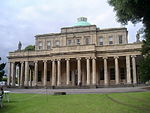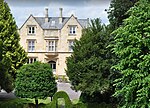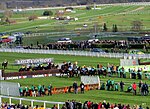Pittville School
Foundation schools in GloucestershireGloucestershire building and structure stubsSchools in CheltenhamSecondary schools in GloucestershireSouth West England school stubs ... and 1 more
Use British English from February 2023
Pittville School is a coeducational foundation secondary school located in the Pittville area of Cheltenham in the English county of Gloucestershire.The school occupies the buildings and grounds formerly occupied by Pate's Grammar School for Girls; the school was founded in 1986, when Pate's moved within Cheltenham as a result of a merger. As a foundation school, Pittville is administered by Gloucestershire County Council. The school also has a specialism in the performing arts.
Excerpt from the Wikipedia article Pittville School (License: CC BY-SA 3.0, Authors).Pittville School
Albert Road,
Geographical coordinates (GPS) Address Phone number Website External links Nearby Places Show on map
Geographical coordinates (GPS)
| Latitude | Longitude |
|---|---|
| N 51.9114 ° | E -2.0635 ° |
Address
Pittville School
Albert Road
GL52 3JD , Cleevemount
England, United Kingdom
Open on Google Maps








